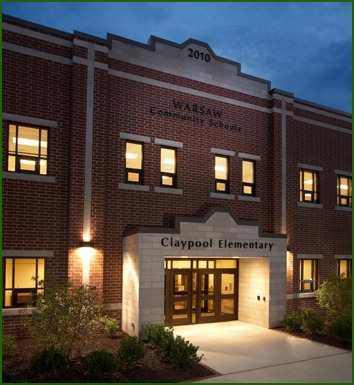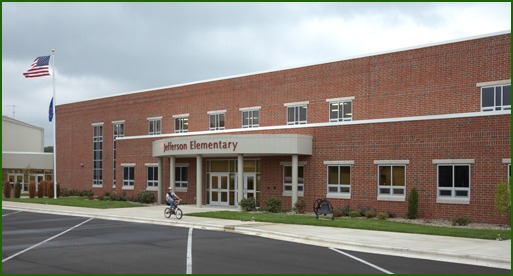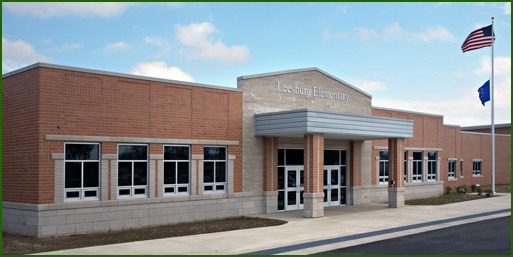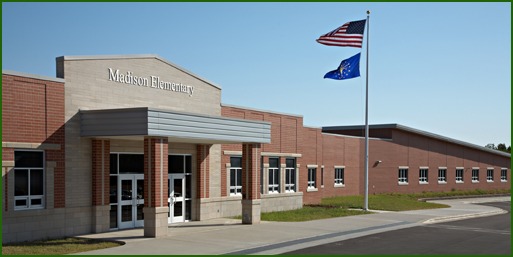Case Study: Rehabs and Restorations
Masonry Construction Creates Durability in Four Indiana Schools
 |
|
| Claypool |
When a northern Indiana school district moved forward with a significant investment in upgrading four elementary schools, the architects used masonry construction to provide long-term performance for the taxpayers, and to create a sense of permanence and community pride for generations to come.
Creating the plan
In early-2007, the Board of the Warsaw Community Schools decided that it was time to take a closer look at how well the district’s facilities met the needs of the area’s children. The 7,000-student district’s buildings ran the gamut from fairly new schools to structures from the early part of the 20th century, and the board wanted to develop a strategic master plan to identify needs and recommendations for improvements. Cost was a major consideration, but there also were concerns in the community about inequities in the quality and resources of specific buildings.
That spring, the board retained Kovert Hawkins Architects to study the facilities, work with staff and community residents to understand the needs, and create that master plan. Next, Kovert Hawkins met with faculty, staff and administrative team members to better define the challenges faced at each school and the inherent deficiencies in the buildings’ designs. The project team presented three options to the school board, each incorporating a cost analysis and the financial impacts.
The board chose an option that included the immediate replacement of Leesburg and Madison Elementary Schools, reopening and renovating the closed Claypool Elementary School, and renovating and adding on to Jefferson Elementary School. Subsequent phases of the option also called for renovations and additions at the four remaining elementary schools, both middle schools, and eventually at Warsaw Community High School.
Four school projects
This article will focus on the four elementary school buildings that were included in the first phase of the option selected by the board. All four were designed and constructed simultaneously. Each presented unique challenges to the team, but the architects determined that masonry construction delivered the most effective solutions in all cases.
At Leesburg and Madison Elementary Schools, new buildings replaced antiquated facilities. According to team leader and Project Architect James Lake, AIA, the buildings are essentially identical.
“We developed a prototype design which served as the ‘ideal’ elementary school for Warsaw’s needs,” Lake says.
A small school in Claypool had been closed for several years and was slated for sale along with two other shuttered buildings. The team converted the outdated single-section building into a three-section facility that includes a new two-story academic building.

Jefferson
Site and budget challenges
The most challenging project was the renovation of Jefferson Elementary, a small building that was completely surrounded by Grace College in Winona Lake. The outdated two-section building was shoehorned between several college buildings and a water tower, leaving little room to move during the process. Adding to the challenge was the fact that the school would continue to be occupied throughout construction. The new design replaced a 1950s-era, single-story section with a two-story academic area, and added new kitchen, cafeteria, and stage spaces to the back of an earlier addition.

Leesburg
Masonry builds durability
Durability was a critical objective for the Kovert Hawkins team. Some of Warsaw’s previous buildings had unexpectedly short service lives before major components began to fail. That was one of several reasons Lake and his team opted for masonry construction at all four buildings.
“We noticed that the newer facilities were comprised of stud construction, with much drywall interior and little masonry on the exterior,” Lake says. “That methodology generally provides a life expectancy of only 20 years before it requires major attention or substantial renovation. The buildings in the best condition were the older ones, which had been constructed with masonry blocks.” They also noted that the new facilities lacked essential storm and tornado shelter areas.
The Leesburg site presented another reason for choosing masonry. “There is no municipal water in Leesburg, and we were initially concerned that we wouldn’t be able to install a sprinkler system,” he explains. “We anticipated that we would have to look at the concept of compartmentalization to provide fire resistance without sprinklers, and masonry would have allowed us to do that.” In the end, the design included two wells and an underground storage tank to feed sprinklers.
“We always look out at least 50 years, and when you look at blocks, bricks and stone, you inherently get 50 years at a very reasonable cost,” Lakes says. “Masonry also provides a sense of strength and longevity beyond its physical durability. There’s the inherent sturdiness and makeup of the material itself, along with the mass that provides sound deadening in interior hallways. You can’t do all that with metal wall panels or other materials.”

Madison
Different designs with similarities
Leesburg and Madison were both designed as single-story buildings. Load-bearing masonry walls are used through the entire exterior and in most interior corridors. The 85- X 92-foot gymnasiums employ free-spanning steel joists across 30-foot-tall load-bearing concrete block walls.
“The blocks provided an extremely durable surface in the areas that receive the most abuse, and assured sufficient protection for storm-safe zones. It also allowed us to construct the spaces quickly, as the finished surfaces could be completed as the blocks were being installed.”
While Claypool and Jefferson were very different situations, the team took a similar design approach, using two-story academic buildings constructed of load-bearing exterior walls and interior corridor walls that were centered on each floor.
“That allowed the exterior building shell to be constructed quickly, so the brick masons could work on the exterior while the block masons continued inside. The load-bearing corridor walls also formed the support for the second-floor framing. Once the second-floor steel joists were set, work commenced simultaneously on both the first and second levels of the addition.”
From an aesthetic standpoint, the designs echo the multi-story brick school buildings that dominated small-town Indiana for most of the 20th century. “We wanted to recall that history, and we believed that the only way to accomplish that was with blocks, bricks and stone,” Lake says. “We included stone on all the buildings, although we used it only on headers and sills at Jefferson, because that material really didn’t exist anywhere on the adjacent Grace College campus.”
The schools stand out as centerpieces of the community, with efficient and sturdy designs and no opulent elements. “We were also able to incorporate some additional masonry components to add character and an extra sense of arrival without adding a lot of extra cost,” Lake explains. “For example, we added some masonry seat walls, landscaping walls, entry gate walls, and monument signs, using materials we already had on the sites.”